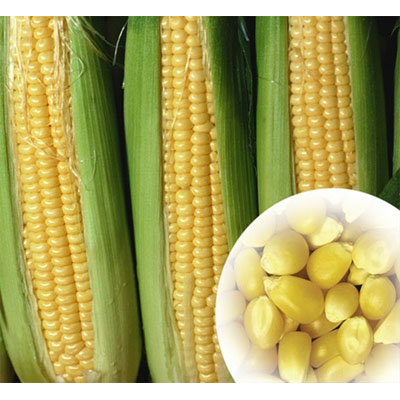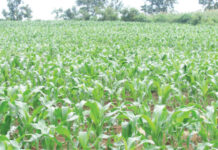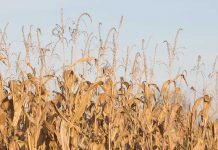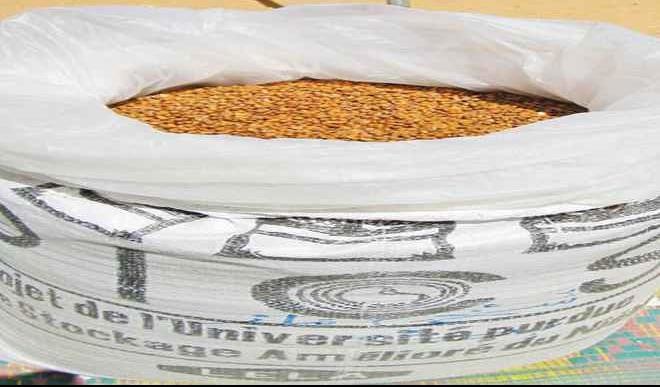Any well drained sandy loam or loamy soil can be used for planting maize but if in doubt, contact your nearest Extension Office or Agro-Service Center.
Land Preparation
Use any method (Mechanical, Chemical and Manual) that can adequately remove weeds and keep the soil loose for good seedbed. As much as possible, incorporate residue of the previous crop into the soil.
For large scale planting, clearing method should ensure preservation of the topsoil when uprooting and clearing trees mechanically. Consult the nearest Extension Office or Agro-Service Center.
Plant immediately after land preparation to allow maize to get ahead of weeds.
CAUTION: When the land is ploughed mechanically, the depth of planting should not be more than 5 cm (2 inches).
Recommended Varieties
EARLY SEASON
YELLOW OPEN-POLLINATED VARIETIES
Western Yellow 1: TZSR-Y-1 (Streak Resistant)
DMR-LSRY (Downy Mildew & Streak Resistant)
YELLOW HYBRID VARIETIES: 8425-8; 8329-15
WHITE, OPEN-POLLINATED VARIETIES: TZPB (FARZ 27); TZB (FARZ 34); TZSR-W-1; ZPBSR (Streak Resistant); DMR-LSRW (Downy Mildew & Streak Resistant).
DMR-LSRW (Downy Mildew & Streak Resistant).
WHITE HYBRIDS
8321-18; 9022-19; (Striga Resistant).
LATE SEASON
Plant early maturing, streak and/or downy mildew resistant varieties.
YELLOW OPEN-POLLINATED VARIETIES: TZESR-Y; DMR-ESRY (Downy Mildew and Streak Resistant).
WHITE-OPEN POLLINATED VARIETIES: TZESR-W; DMR-ESRW (Downy Mildew and Streak Resistant)
POPCORN: White Pop: Yellow composite.
Time of Planting
EARLY SEASON
(i) In the Forest zone, the optimum planting date is between 15 March and 1 April, although planting could be done as soon as rainfall becomes steady.
(ii) In the Derived Savannah zone, plant as soon as the rainfall becomes steady, between 1-30 April.
(iii) In the Southern Guinea Savannah zone, planting could still be done as late as May and June, depending on rainfall.
LATE SEASON
Late season maize is recommended only for areas where rainfall is likely to be adequate. Popcorn is best planted in the late season where proper drying could be easily effected for optimum popping expansion. Planting should be done preferably between 1–15 August.
Seed Rate and Plant Population
SEED RATE
(i) 25 kg/ha for open pollinated varieties
(ii) 15 kg/ha for Hybrids
(iii) 15 kg for popcorn.
PLANT POPULATION
(i) Open-Pollinated/Popcorn varieties: Hand planted, 90 cm x 40 cm, 2 plants/stand to give 55,555 plants/ha.
(ii) Hybrids: Hand planted, 90 cm x 40 cm, 2 plants/stand to give 55,555 plant/ha.
(iii) Mechanical Planting: (Any Variety)
75 cm x 25 cm , 1 plant/stand to given 53,555 plants/ha or 90 cm x 20 cm, 1plant/stand giving 55,555 plants/ha. There should be no thinning or supplying except in very bad cases.
N.B. Always use certified seeds of recommended varieties for good crop establishment.
Fertilizer rate and time of application
OPEN-POLLINATED VARIETIES
(i) Forest fallows 10 years or more. Apply 200 kg (4 bags) of NPK 25-10-10 per hectare at planting as band or broadcast application (equivalent to 50 kg N, 20 kg P2O5 and 20 kg K2O) per hectare). Local unit is ONE empty beer bottle cap to two plants.
(ii) Forest fallows less than 10 years, soils under savanna vegetation and soils under continuous cropping: Apply 300 kg (6 bags) of NPK 25:10:10 and 100 kg (2 bags) of Single Super-phosphate per/ha at planting as band or broadcast application (equivalent to 75 kg, 50 kg P2O5, 30 kg K2O, and 14 kg S per/ha). Alternatively, apply 400 kg (8 bags) of 20:10:10-2S-1Zn per/ha at planting. Local unit is ONE empty beer bottle cap to every one plant.
(iii) In the savanna zone, apply 400 kg (8 bags) of 25:10:10, 100 kg (2 bags) of Single Super-phosphate and 3 to 5 kg of Zinc Sulphate per/ha at planting as band or broadcast application, to give 100kg N, 58 kg P2O5; 40 kg K2O, 14 kg S and 1 to 2 kg Zn per/ha. Alternatively apply 500 kg (10 bags) of 20-10-10-2S-1Zn per/ha at planting.
HYBRIDS
For every high yields, apply 600 kg (12 bags) of 25:10:10 per hectare in two splits at planting (200 kg) and 5 to 6 weeks after planting (400 kg), to give 150 kg N, 60 kg P2O5 and 60 kg K2O per hectare. In the savanna zone, add 200 kg (2 bags) of Single Super-phosphate and 5kg of Zinc Sulphate to give a total of 150 kg N, 78 kg P2O5, 60 kg K2O, 14 kg S and 2 kg Zn. Alternatively, apply 500 kg (10 bags) of 20:10:10-2S-1Zn/ha at planting and a second dose of 100 kg (2 bags) of Urea per hectare.
LATE SEASON
Fertilizer rate and time of application are the same as for early season.
CAUTION
It is ideal to carry out soil testing before any fertilizer application.
If the above fertilizer recommendation has been used repeatedly on the same field for more than four years, it is advisable to submit soil samples for testing before further application. This service is available at I.A.R.&T., Moor Plantation, Ibadan.
Weed Control
HAND WEEDING
Carry out the first weeding 14–21 days after planting or as soon as necessary. A second weeding may be done if necessary before the second application of fertilizer.
HERBICIDE APPLICATION
Apply Atrazine pre-emergence at the rate of 3 kg ai/ha on a clean seed bed. For 50% flowable (PW), rate is 3.0 kg active ingredient per hectare. (Local unit is 1 small tomato tin full/4.5 liters (1 gallon) of water. For type 80% wettable powder, rate is 3.0 kg active ingredient per hectare. Local unit is approximately one standard match box full/4.5 liters (1 gallon) of water.
Volume of Water to be used: Ideally, the sprayer should be calibrated to determine the spray volume. As a guide, however:
(i) for tractor-mounted Boom Sprayer, use 200-225 litres of water per hectare.
(ii) For pressurized knapsack sprayer (C.P.3), use 400 litres of water per hectare.
NOTE
(i) Where grass weeds predominate, use primextra, 2.5 kg ai. per hectare or Lasso/Atrazine, 2.5 kg ai/ha (5 liters of commercial product per hectare).
(ii) Where sedges pose a problem, use Butylate (Sutan) at the rate of 3–4 kg active ingredient per hectare or Stomp (Pendimethalin) at the rate of 1.0–2 kg ai/ha (2–4 liters of product/ha) pre-plant incorporated herbicide.
(iii) Where corn grass (Rottboellia cochinchinensis) predominates, use a mixture of Atrazine (2 kg) and Pendimelthalin (Stomp, Prowl; at 1.5 kg ai/ha).
(iv) In striga endemic areas, use striga resistant maize seed varieties and practise integrated farming system.
DISEASES
Some important diseases of maize are Maize Streak Virus, Downy Mildew, and Highland Blight among others. Plant early to minimize attack by diseases.
INSECTS
(i) STEMBORERS: Where stemborer control is required, apply FuradanTM 3G or 10 g (carbofuran) at the rate of 0.75 kg ai/ha as side dressing, 10 cm away from maize stands, 7 days after emergence or as seed dressing with a sticker prior to planting. Apply 1.68 kg active ingredient carbaryl (Vetox 85TM) at 225 litres of water/ha. Local unit is 8 levels of standard match box per 9 litres (2 gallons) of water. Two applications at fortnightly intervals starting 2 weeks after planting should be made.
(ii) ARMY-WORMS AND GRASSHOPPERS: Where infestation by these insects has been detected, control immediately with monocrotophos (e.g. Azodrin at 33 ml/liter, Nuvacron 40 ECTM at the rate of 40 ml/10 litres of water) and ultracide 40 at 40 ml/10 liters of water).
(iii) TERMITES: If termites attack is detected during the growing season, spray the affected area with 30 ml of Nogos 50 in 4.5 liters of water. Termite hills in the field and surrounding area should be located and destroyed.
(iv) CORN EARWORMS: For green maize production in particular and increased grain yield, apply 3 sprays of cymbush 10 EC of Ambush 25 EC at the rate of 20ml/10 liters of water at weekly interval, beginning from 50% silking. Direct spray to the cobs.
Harvesting
Harvest maize as soon as ripe for the purpose desired, undue delay in harvesting increases damage due to diseases and pests.
Expected Yield
If the above recommendations are followed and rainfall is adequate, a yield range of 2,000–3000 kg/ha for open pollinated, 2,000–2,500 kg/ha for popcorn and 3,000–4,000 kg/ha for hybrid could be obtained in the Southern Nigerian zone.
In the Nigerian Savannah zone, 3–4 tonnes/ha for Open Polinated and 5–6 tonnes/ha for Hybrid 4.
Storage

CRIB STORAGE
Use the maize crib as a storage and drying equipment. The crib can be constructed with farm materials, sawn wood, or metal.
While storing maize on the cob in the crib, use Actellic 25 EC at 200 ml/10 litres of water applied with knapsack
Maize crib constructed using sawn wood and metal sheets. sprayer or flit gun, or 0.4–0.5 kg Actellic 2% Dust/tonne depending on the level of damage.

WAREHOUSE STORAGE
Bagged maize must be stored on pallets or dunage in stacks in the warehouse. The stacks should be numbered for recording date of formation, history of pest control, and moisture content.
For long periods of storge, protect grain from insect damage by using Phostoxin I tablets, 1 tablet/25 or 50 kg bag for maize grains stored in polythene bags or air-tight containers or 1 tablet/100 kg in silos.
DOMESTIC STORAGE
Store properly dried maize in air-tight containers like metal drums, plastic containers with screw caps, or polythene bags. Control infestation by fumigating with 1 tablet of Phostoxin to one bag of shelled grain.






